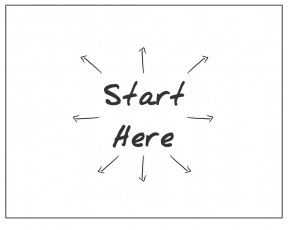Blog: Design Musings and Other Nonsense
We discuss design, business, web products and other miscellany.
UX Design: Sometimes You Need to Start Before You are Ready
I like to fancy myself a visual thinker, and when it comes time to design something new, usually I can get a pretty clear picture in my head of what I want to build before I start. It is not uncommon for me to see a flash go through my mind of the thing I am about to build already done, before I even start. In this case, designing is a matter of working with the items in the screen until they match the picture in my head (or something better).
Sometimes, though, when I sit down to design something, I don’t have a picture in my mind. This usually happens on the more loosely defined designs, where the intention of the design is a bit muddled, or on the designs where I don’t know exactly what I am trying to build (or why I am building it). In these cases, I need to alter my method a bit. That is, I need to start designing before I know what my design will look like.
Doing this, though, goes against my grain. By starting a design before I can see it feels premature. I guess this is due to how I normally work through projects. That is, I typically start with the end in mind and walk a project through anything needed to get it there. However, I have found that waiting for the picture of the end product to show up before I start can be not only a waste of time, but can actually hold me back.
What I have found is that in some cases it is key to start before I am ready. Some of the best designs I have done I had ZERO idea what I was going to build when I sat down. By not having a clear picture in my mind when I start, I am forced to build the design piece by piece. I usually start with the obvious stuff (usually branding and/or top nav) and go from there. One I thing I find when I work a design this way is that all of the pieces seem to integrate better. Since I add the pieces one at a time, I can sculpt each one to be “just right” before I move on to the next one. And, if I have to change a piece later, the change is easier too make because I (intimately) understand how that piece interacts with the whole of the design.
Even though it feels against my nature to design this way, I feel it makes me a better designer for being able to do it. Projects in the real world do not always have clear definitions and direction, and it is nice to have a tool bag to be able to pull from. Real life can be messy, and often we cannot understand everything about what we are trying to build before we build it. In these situations, I have found a one step at a time approach will usually yield the best results. I may not be able to predict what I am going to build before I start, but by keeping focused on the big points I want to hit, I am usually able to work a design until it does what I need it to do.

